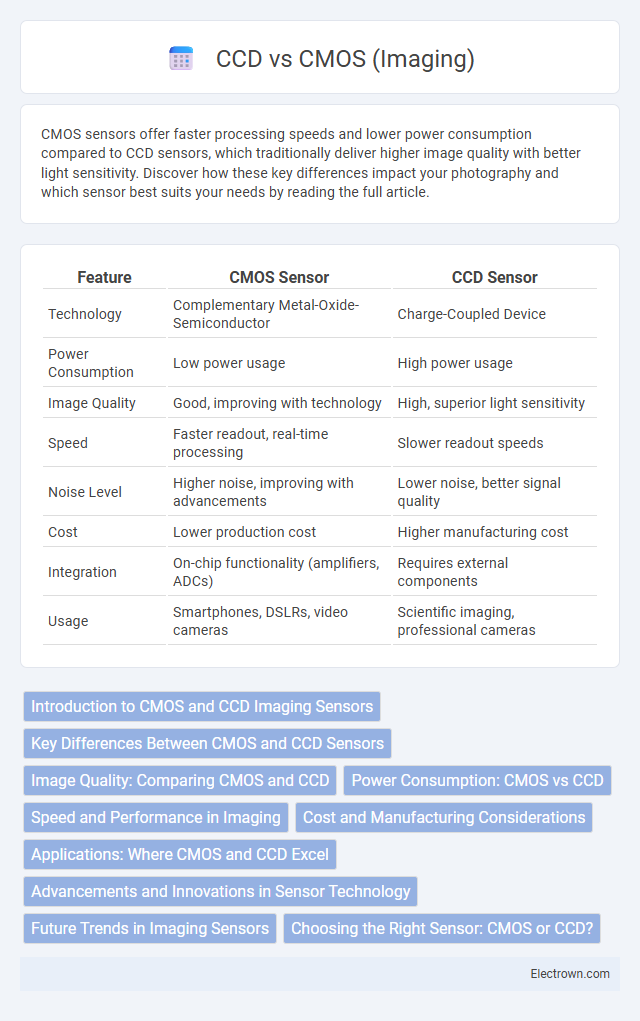CMOS sensors offer faster processing speeds and lower power consumption compared to CCD sensors, which traditionally deliver higher image quality with better light sensitivity. Discover how these key differences impact your photography and which sensor best suits your needs by reading the full article.
Table of Comparison
| Feature | CMOS Sensor | CCD Sensor |
|---|---|---|
| Technology | Complementary Metal-Oxide-Semiconductor | Charge-Coupled Device |
| Power Consumption | Low power usage | High power usage |
| Image Quality | Good, improving with technology | High, superior light sensitivity |
| Speed | Faster readout, real-time processing | Slower readout speeds |
| Noise Level | Higher noise, improving with advancements | Lower noise, better signal quality |
| Cost | Lower production cost | Higher manufacturing cost |
| Integration | On-chip functionality (amplifiers, ADCs) | Requires external components |
| Usage | Smartphones, DSLRs, video cameras | Scientific imaging, professional cameras |
Introduction to CMOS and CCD Imaging Sensors
CMOS (Complementary Metal-Oxide-Semiconductor) and CCD (Charge-Coupled Device) are two primary types of imaging sensors used in digital cameras and imaging devices. CMOS sensors integrate amplifiers and digitization circuits on the same chip, enabling lower power consumption and faster readout speeds compared to CCD sensors, which transfer charge across the chip to a single output node. CCD sensors generally offer higher image quality with lower noise and better light sensitivity, while CMOS sensors have become more prevalent due to advances in semiconductor technology and cost efficiency.
Key Differences Between CMOS and CCD Sensors
CMOS sensors use active pixel technology allowing faster readout speeds and lower power consumption, while CCD sensors transfer charge across the chip and typically offer higher image quality with lower noise in low light. CMOS sensors integrate amplifiers and noise correction circuits on each pixel, providing better flexibility and cost efficiency, whereas CCDs rely on specialized manufacturing processes that increase production costs. The key differences between CMOS and CCD sensors lie in their architecture, power efficiency, image quality, and manufacturing complexity, with CMOS dominating in consumer electronics and CCD preferred in high-end imaging applications requiring superior light sensitivity.
Image Quality: Comparing CMOS and CCD
CMOS sensors offer faster readout speeds and lower power consumption while providing high image quality with less noise in well-lit conditions. CCD sensors excel in low-light environments due to higher sensitivity and superior dynamic range, resulting in crisper, cleaner images with better color accuracy. Your choice between CMOS and CCD will impact image clarity, especially under varying lighting conditions.
Power Consumption: CMOS vs CCD
CMOS sensors consume significantly less power than CCD sensors due to their efficient on-chip integration and simpler readout circuits, making them ideal for battery-powered devices. CCD sensors require higher voltage and consume more energy because their charge transfer process demands greater power. Your choice between CMOS and CCD imaging should consider power consumption needs, especially for portable or energy-sensitive applications.
Speed and Performance in Imaging
CMOS sensors generally offer faster image capture speeds compared to CCD sensors due to their parallel processing capabilities and lower power consumption. CCD sensors excel in image quality with superior light sensitivity and low noise levels but often exhibit slower readout speeds, making them less suited for high-speed imaging applications. Advances in CMOS technology have narrowed the gap, providing high frame rates and improved dynamic range that meet the demands of modern high-performance imaging systems.
Cost and Manufacturing Considerations
CMOS sensors are generally more cost-effective to manufacture due to their compatibility with standard semiconductor fabrication processes, enabling integration with other circuitry on a single chip and reducing production complexity. CCD sensors require specialized manufacturing techniques that increase production costs and limit scalability, making them less economically viable for mass-market applications. The lower power consumption and simpler assembly of CMOS technology further contribute to its widespread adoption in cost-sensitive imaging devices.
Applications: Where CMOS and CCD Excel
CMOS sensors excel in applications requiring high-speed imaging and low power consumption, such as smartphones, webcams, and automotive cameras. CCD sensors are preferred in scientific imaging, astronomy, and professional photography due to their superior light sensitivity and low noise performance. Your choice depends on whether you prioritize speed and integration (CMOS) or high image quality in low-light conditions (CCD).
Advancements and Innovations in Sensor Technology
CMOS sensors have advanced with innovations like backside illumination (BSI) and stacked architectures, leading to improved low-light performance, faster readout speeds, and reduced power consumption compared to traditional CCD sensors. CCD technology continues to evolve with advancements in charge transfer efficiency and noise reduction, maintaining high image quality in scientific and industrial applications. Emerging hybrid sensors combine CMOS and CCD elements, leveraging the strengths of both technologies for enhanced dynamic range and sensitivity.
Future Trends in Imaging Sensors
Future trends in imaging sensors emphasize the advancement of CMOS technology due to its lower power consumption, faster readout speeds, and greater integration capabilities compared to CCD sensors. Innovations in CMOS sensors include improved quantum efficiency, reduced noise levels, and enhanced dynamic range, enabling applications in autonomous vehicles, medical imaging, and augmented reality. Emerging developments also involve stacked CMOS architectures and global shutter mechanisms, which aim to overcome limitations traditionally dominated by CCD technology.
Choosing the Right Sensor: CMOS or CCD?
Choosing the right imaging sensor depends on your specific needs, as CMOS sensors offer faster readout speeds and lower power consumption, ideal for high-speed photography and video applications. CCD sensors excel in image quality with better light sensitivity and lower noise, making them suitable for professional photography and scientific imaging where detail is crucial. Your decision should consider factors like frame rate, image resolution, power efficiency, and budget to select the sensor that best aligns with your imaging goals.
CMOS vs CCD (Imaging) Infographic

 electrown.com
electrown.com